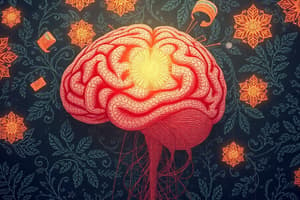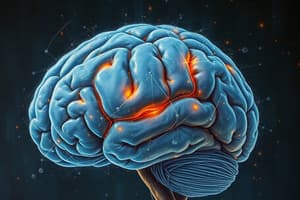Podcast
Questions and Answers
What area of the brain showed a significant increase in grey matter for jugglers compared to non-jugglers?
What area of the brain showed a significant increase in grey matter for jugglers compared to non-jugglers?
- Cerebellum
- Basal ganglia
- Mid-temporal area (correct)
- Frontal lobe
How long after participants ceased juggling was a decrease in grey matter observed?
How long after participants ceased juggling was a decrease in grey matter observed?
- Three months (correct)
- One month
- Two months
- Six months
What aspect of memory does juggling primarily relate to according to the study?
What aspect of memory does juggling primarily relate to according to the study?
- Implicit memory
- Visual memory (correct)
- Declarative memory
- Motor memory
What method was used to analyze the MRI scans in the study?
What method was used to analyze the MRI scans in the study?
Which limitation was identified for the study's experimental design?
Which limitation was identified for the study's experimental design?
What is the main subject of the study conducted by Draganski in 2004?
What is the main subject of the study conducted by Draganski in 2004?
What physiological process is associated with the strengthening of synapses?
What physiological process is associated with the strengthening of synapses?
Which age group were the participants in the Draganski study?
Which age group were the participants in the Draganski study?
What was used as a base for assessing changes in brain structure in the study?
What was used as a base for assessing changes in brain structure in the study?
What happens to neural connections when a behavior is discontinued?
What happens to neural connections when a behavior is discontinued?
Which group served as the control in the Draganski study?
Which group served as the control in the Draganski study?
What is dendritic branching associated with in the context of neuroplasticity?
What is dendritic branching associated with in the context of neuroplasticity?
What major conclusion can be drawn from the findings of Draganski's study?
What major conclusion can be drawn from the findings of Draganski's study?
Flashcards
Neuroplasticity
Neuroplasticity
The brain's ability to change its neural structures to adapt to change.
Dendritic branching
Dendritic branching
A type of neuroplasticity involving the growth of more connections (dendrites) between neurons.
Neural pruning
Neural pruning
The process by which extra neurons and synaptic connections are eliminated, part of neuroplasticity.
Long-Term Potentiation (LTP)
Long-Term Potentiation (LTP)
Signup and view all the flashcards
Juggling study (Draganski, 2004)
Juggling study (Draganski, 2004)
Signup and view all the flashcards
MRI Scan
MRI Scan
Signup and view all the flashcards
Participants (Juggling study)
Participants (Juggling study)
Signup and view all the flashcards
Control group
Control group
Signup and view all the flashcards
Voxel-Based Morphometry (VBM)
Voxel-Based Morphometry (VBM)
Signup and view all the flashcards
Grey Matter Change in Jugglers
Grey Matter Change in Jugglers
Signup and view all the flashcards
Control Group in Study
Control Group in Study
Signup and view all the flashcards
Pre-test/Post-test Design
Pre-test/Post-test Design
Signup and view all the flashcards
Experimental Study
Experimental Study
Signup and view all the flashcards
Study Notes
Neuroplasticity Study (Draganski 2004)
-
Study Aim: Investigate if learning a new skill (juggling) affects brain structure.
-
Participants: 24 volunteers (21 female, 3 male), aged 20-24, initially non-jugglers.
-
Procedure: Participants were divided into two groups: jugglers and non-jugglers. Jugglers were taught a three-ball cascade juggling routine and practiced until mastery. All participants underwent MRI scans at three stages: baseline, post-juggling practice, and 3 months after stopping.
-
Neuroplasticity: The brain's ability to change neural structures in response to experience and environment.
-
Synaptic Enhancement: Synapses strengthen with repeated actions, a process known as Long Term Potentiation (LTP).
-
Dendritic Branching (Arborization): Repetition leads to increased neural density, via dendritic branching.
-
Neural Pruning: Discontinuation of activities can result in the elimination of extra neurons and synaptic connections.
-
Grey Matter Changes: Jugglers exhibited increased grey matter density in the mid-temporal area (visual memory).
-
Control Group: The non-juggling group showed no significant structural changes throughout the study.
-
3-month follow-up: Grey matter in the mid-temporal area of jugglers decreased after cessation of juggling.
-
Potential mechanisms: Juggling might rely more on visual memory, rather than procedural memory.
Study Design and Evaluation
- Pre-test/Post-test Design: The study's design allowed researchers to observe changes over time, potentially demonstrating cause-and-effect relationships.
- Experimental design: Inclusion of a control group enhances the study's validity and avoids confounding factors.
- Small Sample Size: A small sample size limits the reliability of the results (potential unreliability of using averages).
- Field Experiment: The experiment was conducted in participants' natural environments (home), which might impact internal validity (potential influences from other experiences).
- Causation vs Correlation: The study may not be able to prove a direct causal link between learning a new skill and changes in brain structure.
Studying That Suits You
Use AI to generate personalized quizzes and flashcards to suit your learning preferences.




